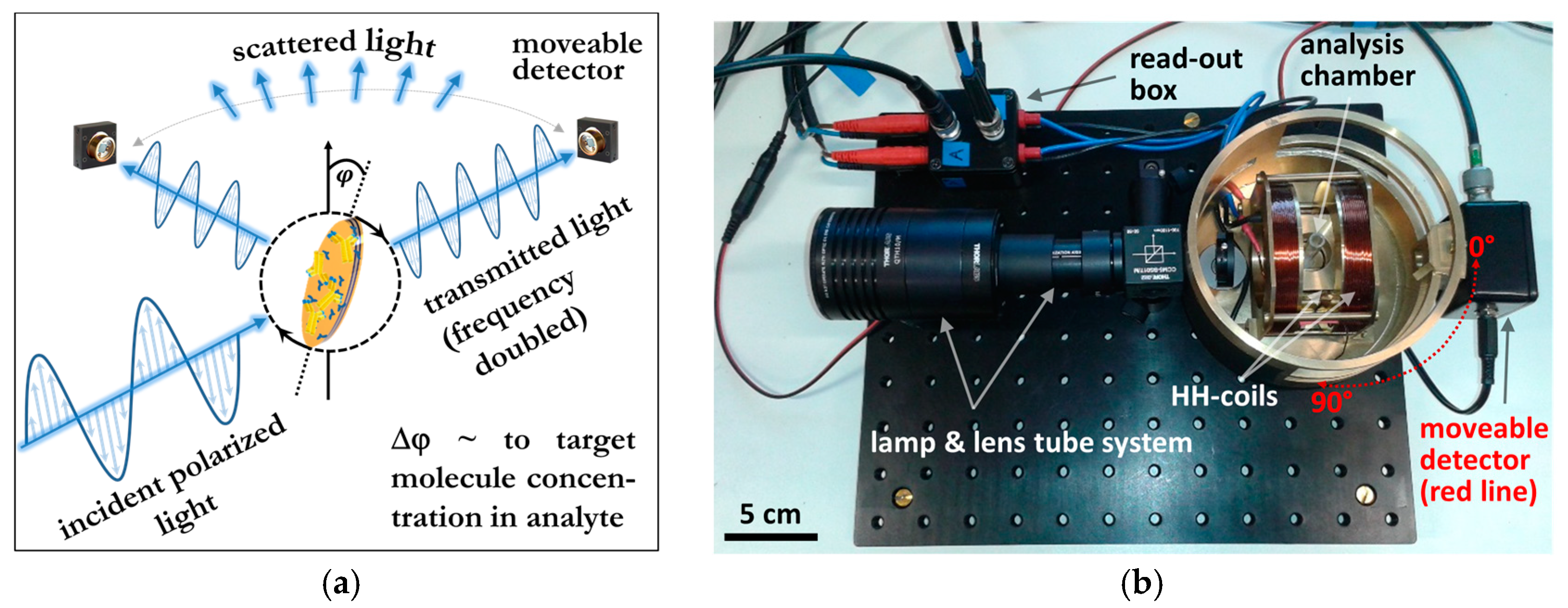Biomolecular Detection Based on the Rotational Dynamics of Magneto-Plasmonic Nanoparticles †
Abstract
:1. Introduction
2. MLoB Detection Principle, Measurement Setup and Validation
3. Numerical Simulations of the Optical Properties of Multicomponent Nanoparticles
4. Nanoparticle Fabrication and Rotational Dynamics Measurements
5. Conclusions
Acknowledgments
Conflicts of Interest
References
- Edwards, D.A. Steric hindrance effects in thin reaction zones: Applications to BIAcore. IMA J. Appl. Math. 2007, 72, 865–893. [Google Scholar] [CrossRef]
- Jennissen, H.P.; Zumbrink, T. A novel nanolayer biosensor principle. Biosens. Bioelectron. 2004, 19, 987–997. [Google Scholar] [CrossRef] [PubMed]
- Liu, X.; Dai, Q.; Austin, L.; Coutts, J.; Knowles, G.; Zou, J.; Chen, H.; Huo, Q. A one-step homogeneous immunoassay for cancer biomarker detection using gold nanoparticle probes coupled with dynamic light scattering. J. Am. Chem. Soc. 2008, 130, 2780–2782. [Google Scholar] [CrossRef] [PubMed]
- Schrittwieser, S.; Schotter, J.; Maier, T.; Bruck, R.; Muellner, P.; Kataeva, N.; Soulantika, K.; Ludwig, F.; Huetten, A.; Brueckl, H. Homogeneous biosensor based on optical detection of the rotational dynamics of anisotropic nanoparticles. Procedia Eng. 2010, 5, 1107–1110. [Google Scholar] [CrossRef]
- Schrittwieser, S.; Pelaz, B.; Parak, W.J.; Lentijo-Mozo, S.; Soulantica, K.; Dieckhoff, J.; Ludwig, F.; Guenther, A.; Tschöpe, A.; Schotter, J. Homogeneous Biosensing Based on Magnetic Particle Labels. Sensors 2016, 16, 828. [Google Scholar] [CrossRef] [PubMed]
- Kwon, B.S.; Zhang, W.; Li, Z.; Krishnan, K.M. Direct Release of Sombrero-Shaped Magnetite Nanoparticles via Nanoimprint Lithography. Adv. Mater. Interfaces 2015, 2, 1400511. [Google Scholar] [CrossRef]
- Draine, B.T.; Flatau, P.J. User Guide for the Discrete Dipole Approximation Code DDSCAT 6.1. Available online: http://arxiv.org/abs/astro-ph/0409262v2 (accessed on 1 August 2017).
- Palik, E.D. Handbook of Optical Constants of Solids; Academic Press: San Diego, CA, USA, 1998. [Google Scholar]
- Li, Z.; Gu, Y.; Wang, L.; Ge, H.; Wu, W.; Xia, Q.; Yuan, C.; Chen, Y.; Cui, B.; Williams, R.S. Hybrid Nanoimprint−Soft Lithography with Sub-15 nm Resolution. Nano Lett. 2009, 9, 2306–2310. [Google Scholar] [CrossRef] [PubMed]




Publisher’s Note: MDPI stays neutral with regard to jurisdictional claims in published maps and institutional affiliations. |
© 2017 by the authors. Licensee MDPI, Basel, Switzerland. This article is an open access article distributed under the terms and conditions of the Creative Commons Attribution (CC BY) license (https://creativecommons.org/licenses/by/4.0/).
Share and Cite
Shoshi, A.; Schneeweiss, P.; Haslinger, M.J.; Glatzl, T.; Kovács, G.; Schinerl, J.; Muehlberger, M.; Brueckl, H. Biomolecular Detection Based on the Rotational Dynamics of Magneto-Plasmonic Nanoparticles. Proceedings 2017, 1, 541. https://doi.org/10.3390/proceedings1040541
Shoshi A, Schneeweiss P, Haslinger MJ, Glatzl T, Kovács G, Schinerl J, Muehlberger M, Brueckl H. Biomolecular Detection Based on the Rotational Dynamics of Magneto-Plasmonic Nanoparticles. Proceedings. 2017; 1(4):541. https://doi.org/10.3390/proceedings1040541
Chicago/Turabian StyleShoshi, Astrit, Pia Schneeweiss, Michael J. Haslinger, Thomas Glatzl, Gábor Kovács, Judith Schinerl, Michael Muehlberger, and Hubert Brueckl. 2017. "Biomolecular Detection Based on the Rotational Dynamics of Magneto-Plasmonic Nanoparticles" Proceedings 1, no. 4: 541. https://doi.org/10.3390/proceedings1040541





